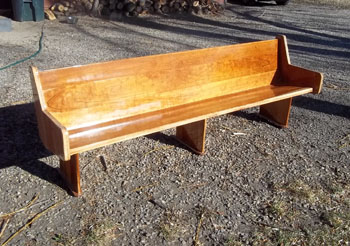
I have acquired a small, very old church pew. It dates from the Civil War and came out of a little Episcopal church that was being torn down. It spent many years in hot and humid conditions and shows much wear. I want to put it on my covered front porch, but I want to put something on it to extend its life. I want to keep the old, worn and aged look, but I want to protect it from our high humidity (we are near the Gulf Coast) and any other moisture. Polyurethane is out of the question. This is an antique, and I don’t want to mess it up with today’s finishes. Any suggestions?
Ellis Wallentine: First, no finish will seal out moisture completely, which means that the pew (as well as every other wooden piece in your house) will eventually come to equilibrium with the humidity in your environment. That’s not a bad thing; it’s just different for different areas of the country. If that pew has been in your locality for over a century, the humidity isn’t going to start affecting it adversely now.
The old, worn and aged look is going to be hard to maintain under any finish except maybe wax, which doesn’t change the color of the wood or saturate the scuff marks that you seem intent on keeping.
It’s hard to imagine a church pew having extraordinary antique value, but if this piece is truly valuable, your most appropriate finish – with the least likelihood of ruining the value of the piece – is likely to be a nineteenth-century spirit varnish concoction, and for that you will have to consult with someone who specializes in historical finishes. If it is intended to be mainly utilitarian, a coat of modern varnish (not polyurethane) might be appropriate. Only you and your appraiser can decide that.
Michael Dresdner: If you really want to extend its life, don’t put it on your front porch. The best way to preserve old wooden objects is to keep them in an environment with stable humidity and temperature. Keeping it outside will shorten its life no matter what finish you apply.
As wood goes through humidity changes, it moves, absorbing and shedding moisture vapor along with the air. Finishes may slow down that rate of absorption by a few hours, or even a day, but they do not prevent it. Hence, if the wood is outdoors, it will go through a lot of movement from season to season. The only consideration with exterior finishes is that they be flexible enough to tolerate that amount of movement without the moving wood cracking the finish. The best flexible finish for exterior wood is spar varnish, and although it was around at least as long as your antique pew, I would not suggest it as a replacement finish. Granted, it would hold up, and add some protection for the wood, but it is not easily reversible, and that is one of the prime considerations for antique restoration.
My suggestion is to finish the pew in shellac, which is both period appropriate and reversible, and keep it indoors. If you must put it outside, finish it with spar varnish, and resign yourself to the fact that it will be used up instead of being preserved. Both of these finishes are compatible over any finish that is likely to be on the pew now.







